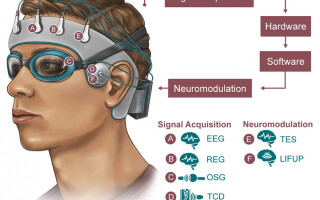Better sleep for soldiers may come through sensor, ML data
StoryDecember 01, 2022

An ongoing project intends to enable military and other scientists to monitor and even enhance the ways in which a soldier’s brain sleeps and, importantly, attains rest and repair. The effort – a collaboration between the U.S. Army Medical Research and Development Command (USAMRDC) Military Operational Medicine Research Program (MOMRP) and scientists and engineers at Rice University (Houston, Texas) – is only one of a group of sensor-driven military projects seeking to create wearable technology to track and improve soldier performance and outcomes.
Scientists at the Houston-based university are developing a noninvasive “sleeping cap” that analyzes the glymphatic system, the flow of fluid that is thought to cleanse and rid the brain of common metabolic waste during sleep. The cap will be used to further understand how the human brain deals with that waste, and if that function actually prepares and refreshes people for the next day.
A team at Rice University’s NeuroEngineering Initiative – together with teams from Rice’s Institute of Biosciences and Bioengineering (IBB) and physicians from Houston Methodist Hospital and Baylor College of Medicine in Houston – are developing a lightweight skullcap that can analyze the wearer’s glymphatic function and stimulate proper flow to treat sleep disorders and improve wakefulness and day-to-day function.
The first year of what the research team anticipates will be a multiyear award from the U.S. Army was funded by a $2.8 million grant through the Army-allied nonprofit Medical Technology Enterprise Consortium, according to a USAMRDC report.
MOMRP director Cmdr. Christopher Steele notes in an announcement from the USAMRDC Public Affairs Office that restful sleep is often difficult for soldiers, particularly in the field: “And so there’s this chronic disruption that we know isn’t good; and while young, healthy individuals can withstand a lot of that, good sleep is a core piece of brain health.”
Steele asserts that over time, constant sleep disruption is known to lead to such conditions as cardiovascular disease, weight gain, hypertension, depression, all of which can result in a compromised and less prepared fighting force.
“Consistent sleep disruption is playing Russian roulette with brain health,” Steele says. “Sleep has to be considered the sixth sense when it comes to determining how an individual is performing over their career, and [also] over standard days and weeks under various stressors.”
The best way at present to view fluid flow in the brain is magnetic resonance imaging (MRI), says Paul Cherukuri, executive director of the IBB, in a story on the project from Rice University. “Since an MRI can’t be easily transported, the Department of Defense asked if we can design a small, portable cap that can measure and modulate the brain health of warfighters during sleep to enhance their performance. Developing this prototype will require us to start with off-the-shelf devices and learn from them in parallel with building our own sensor technology and algorithms at Rice.”
Behnaam Aazhang, director of the Rice NeuroEngineering Initiative and the J.S. Abercrombie Professor of Electrical and Computer Engineering at Rice, says of the cap: “We’re aiming for something practical and portable that is easy to use and can be available to soldiers and patients all the time.” (Figure 1.)

[Figure 1 | This illustration from Rice University depicts the initial design for the noninvasive “sleeping cap” technology currently being developed by Rice University engineers, the U.S. Army, and several other institutions. Courtesy Rice University.)]
Dr. Eugene Golanov and Dr. Gavin Britz of Houston Methodist became interested in the field after discovering disturbances in the glymphatic system after patients experienced brain hemorrhage, according to the Rice story. The recently discovered glymphatic system pumps cerebrospinal fluid into the brain during sleep, flushing misfolded proteins and other biochemical waste.
“We demonstrated that abnormalities of this system affect the brain,” says Britz, the Candy and Tom Knudson Centennial Chair in Neurosurgery and director of the Houston Methodist Neurological Institute. “Sleep is the body’s natural method of clearing these abnormalities.
“This unprecedented collaboration will not only give us more ideas for helping our soldiers in the field but also provide the spark for investigating and treating all brain diseases quickly and in real time,” Britz says. “This will crack open a new field of gathering brain data noninvasively, and it’s never been done before.”
The final device will ideally combine and analyze multiple streams of data through machine-learning software developed at Rice. According to MRDC, given the current pace of this work, a prototype “sleeping cap” is scheduled to be available by the end of 2022 or early 2023.






